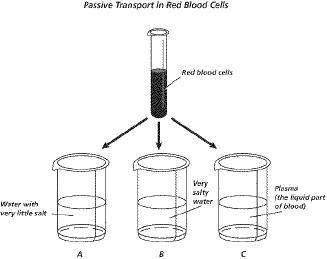
Biology, 26.10.2019 15:43 gonzalesnik
100 points, brainliest, and free points if you answer all correctly
1.use the diagram to answer the question.
what would happen if some of the red blood cells were placed in beaker b?
water would move into the cells by osmosis, causing the cells to shrink.
water would move out of the cells by osmosis, causing the cells to shrink.
water would move into the cells by osmosis, causing the cells to swell.
water would move out of the cells by osmosis, causing the cells to swell
2.
use the diagram to answer the question.
what would happen if some of the red blood cells were placed in beaker a?
water would move into the cells by osmosis, and the cells would swell.
water would move out of the cells by diffusion, and the cells would shrink.
water would move out of the cells by osmosis, and the cells would shrink.
water would move into the cells by diffusion, and the cells would swell.
3.
what would occur if some of the red blood cells were placed in beaker c? recall that red blood cells normally float in plasma.
the concentration of water inside and outside the cells would be equal, so no osmosis would occur.
the concentration of water inside and outside the cells would be equal, so no diffusion would occur.
the concentration of water inside the cells would be less than outside, so the cells would swell.
the concentration of water inside the cells would be greater than outside, so the cells would shrink.
4.
what is a function of water in a cell?
producing lipids and carbohydrates
assisting in the production of proteins
the cell move and grow
preventing rapid temperature changes
5.
the cell membrane and water are both involved in
directing the cell’s activities and functions
the movement of materials into and out of the cell
preventing chemical reactions from taking place
making and packaging proteins for the cell
6.
the cell membrane and water are both involved in
directing the cell’s activities and functions
the movement of materials into and out of the cell
preventing chemical reactions from taking place
making and packaging proteins for the cell
7.
which are types of passive transport?
osmosis and diffusion
diffusion and engulfing
transport proteins and osmosis
engulfing and transport proteins


Answers: 1


Other questions on the subject: Biology


Biology, 22.06.2019 09:30, michellemonroe012305
How energy flows through each level in this energy pyramid. is all the matter and energy from one level transferred to the next level?
Answers: 1

Biology, 22.06.2019 11:30, rockinrachel9099
Which organism can most likely be classifild as domain bateria
Answers: 1
You know the right answer?
100 points, brainliest, and free points if you answer all correctly
1.use the diagram to...
1.use the diagram to...
Questions in other subjects:

History, 03.02.2021 22:50


Mathematics, 03.02.2021 22:50


Spanish, 03.02.2021 22:50


Mathematics, 03.02.2021 22:50



Mathematics, 03.02.2021 22:50



